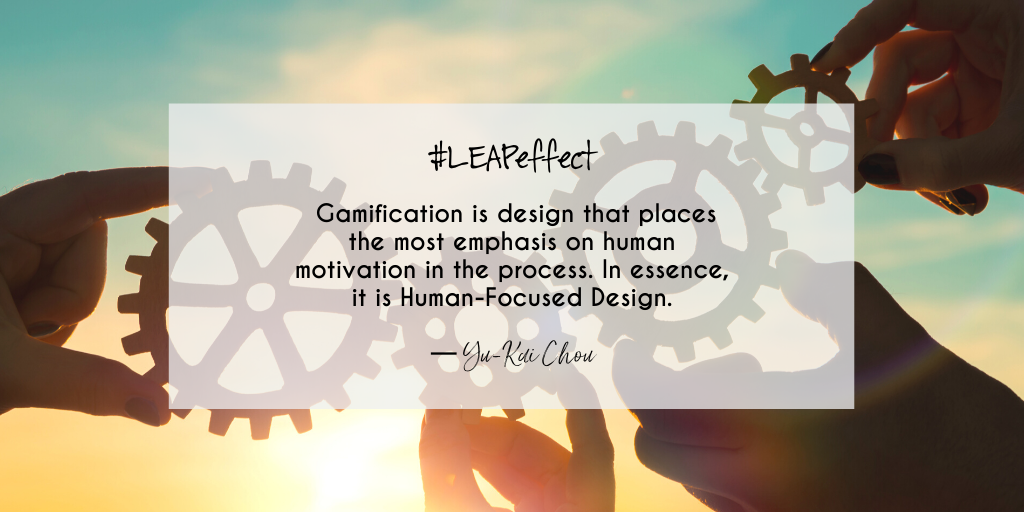The Elements of Game Design that Elevate Engagement and Drive Learning

When learners perceive something as relevant, they desire to learn and know more. Video games and their themes are tailored for targeted audiences and designed to capture that specific audience’s full attention. Think, ultimate engagement. Whether it be the storyline, characters, or challenges, learners connect to the premise of the game. Games are filled with novelty and discovery; they are created to stir curiosity and pull in players. The best games provide choice—in avatars, actions, player modes, and play (solo or collaborative). In Fortnite, for example, learners have the option to compete independently, collaborate with a team, or enter playground mode to build and design. These choices give them the autonomy to create their own experiences.
A Balance of Challenge and Perceived Skill
As kids engage in video gaming, they make predictions on what to do next to achieve a challenge. This may entail an action, choice or prediction, and even input from their peers. If what they do is correct, they advance to the next level—and receive another boost of dopamine. The challenge and reward process fuels the brain to continue working toward the next achievement. Every time they reach success, they’re motivated to continue trying repeatedly. For optimum engagement, the level of challenge and perceived skill must be balanced. Tracy Fullerton, author of Game Design Workshop: A Playcentric Approach to Designing Innovative Games, explains, “If the level of challenge remains appropriate to the level of ability, and if this challenge rises as the ability level rises, the person will stay in the center region and experience … ‘flow.’ In flow, an activity balances a person between challenge and ability, frustration and boredom, to produce an experience of achievement and happiness.”
Incremental and Intuitive Success
Video games provide incremental success by allowing players to advance to new levels, but never at a rate quicker than what they can master. With deep determination, kids will attack challenges until they reach success, only to persist to the next level. Interestingly, while playing video games, kids face failure 80 percent of the time, but because they receive feedback that they’re gradually reaching their goal—they can see their progress and experience moments of success—they continue to persist in the face of challenge. In Super Mario Bros, gamers can see all of the worlds that lie ahead, awaiting to be unlocked and explored. They have an idea what the challenges before them may be, and they know where they’ll end up. But until they begin, they’re not certain how to conquer the upcoming challenges.
Immediate Feedback
The immediate feedback players receive while playing entices them to continue pushing forward. They instinctively learn to make predictions based on past performance indicators that signal how to improve during the next attempt. Despite the fact that there is no tangible trophy or formal awards ceremony where families gather, they persevere forward with feedback in the form of chimes, graphic displays, power-ups, coins, or new digital tools and even outfits for their avatars. Every bit of feedback the brain receives reinforces networks of memory used to predict success. When my husband and I purchased Super Mario Bros. for our boys, we didn’t sit down with a manual or instruct our boys on how to use the controllers or what to do in the first level. We simply provided the freedom for them to explore and learn by doing. (I suppose we took somewhat of a constructivist approach with video gaming, if that’s a thing.) Our boys engaged in a productive struggle as they faced challenges and worked to overcome them through trial and error. They used feedback from the game to adjust their approach and retool their technique, and they successfully unlocked all the lands over time.
Identity, Personalization, and Sense of Connectedness
From Minecraft to Fortnite, learners create their own identities based on their interests and how they want to be perceived by others. They build their own dwellings and can wear “skins” to communicate their personality. Although kids often desire to connect and have friendships based on interests and commonalities, they also enjoy showcasing their originality in the “safety” of the gaming world, as it’s customizable on demand. Through gaming, they also develop a sense of connectedness through partnering on missions or creating worlds with their imaginations. Connectedness fosters a sense of community and belonging and develops the foundation for communication leading to new ideas.
In learning, we can infuse elements of game design in the following ways:
• Providing choice
• Facilitating with inquiry
• Promoting collaboration and effective communication
• Empowering learners to pinpoint relevant topics, challenges, or problems that exist
• Inviting discovery through exploration
• Fostering a culture that embraces a growth mindset
• Leveraging the strengths of learners
• Engaging learners in productive struggle
• Ensuring that learners receive both independent and small group support at a level of growth
• Developing a plan for goal setting, monitoring, and celebration of all levels of success
• Employing tools that allow for immediate feedback
• Empowering learners to demonstrate their learning, leveraging their strengths and creativity
Everything from relationships, engagement and empowerment, relevance, communication, and more embedded here in the elements of game design. As educators, we must be aware of our focus: Is it simply delivering the content we need to teach? Or, do we focus on creating experiences that draw kids in; sparking motivation to want to learn? Creating novel experiences that leverage the interests of students can take more time than simply sticking to the traditional approaches, but the payoff is worth every ounce of effort. Research suggests that superior learning takes place when classroom experiences are enjoyable and relevant to students’ lives, interests, and experiences. If new to you, simply begin with one element and continue building from there. We are all on our own unique learning journey and as long as we continue moving forward, we make progress and an even greater impact!

